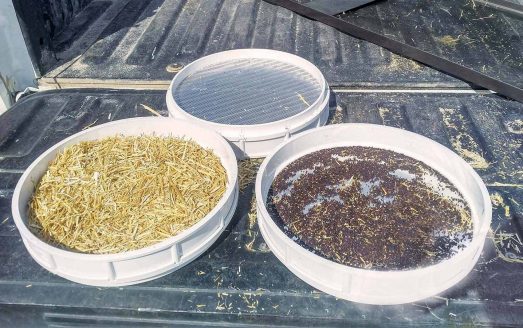Cut later to increase yield with no extra cost
Harvest management is one of the five pillars in the Canadian canola industry’s goal to increase average yields to 52 bu./ac. by 2025. Cutting later and taking steps to reduce combine losses can have a big impact on harvest yield with no extra cash costs.
Here are some things farmers can do:
Cut later. A trend to delayed cutting – either through later swathing or straight combining – will increase yield over earlier cut timings. Canola Council of Canada research from the early 2000s showed that canola fields swathed at 60 per cent seed colour change (SCC) on the main stem can yield eight per cent more than fields swathed at 30 per cent SCC. The yield difference could be even higher with lower plant populations because with fewer larger plants more of the yield will be in the side branches. Overall losses do not differ between late-swathed and straight-cut canola, according to research by Teketel Haile in 2014 and Rob Gulden in 2016.
Hit plant establishment targets. Achieving the target of six to eight plants per square foot (read the plant establishment article on page 10) will mean fewer side branches, which has benefits for harvest timing and possibly quality and yield. Seeds in side-branch pods mature later, and the more branches, the longer a canola crop takes to mature. With dry fully mature seeds and green immature seeds in the same plant, it can be difficult to choose an appropriate time to swath or to apply pre-harvest aids. This can have implications for yield if earliest pods are shelling out while the latest pods are too green to mature properly. For more on plant populations and side branching, read “Swath timing: Plant population and SCC” at canolawatch.org.
Use the new Combine Optimization Tool at canolacalculator.ca to work through a series of adjustments to reduce harvest losses.
Check for losses. Canola growers can lose up to 5 bu./ac., or more, while combining. Checking for combine losses under various conditions will give operators a feel for best settings under various conditions. It will also help to interpret what combine loss monitors are really saying. For tips, read “How to reduce costly harvest losses” at canolawatch.org. The new Combine Optimization Tool at canolacalculator.ca will help farmers assess the risk situation and walk through an appropriate series of adjustments to combine settings.

Use genetics to expand harvest options and reduce losses. Pod shatter reduction, a feature available with some canola varieties from various seed companies, can reduce the risk for canola left standing for later swathing or straight combining.
Protect the crop in storage. World-grain.com says some countries often experience post-harvest losses of 30 to 40 per cent. Cold winters on the Canadian Prairies offer some protection against deterioration, but losses can still be substantial if canola is not dry and cool and monitored regularly. Safe storage recommendations for canola – eight per cent moisture and less than 15°C – are based on research from the 1980s and have become standard practice for canola producers. For canola stored winter to summer, recent Prairie Agricultural Machinery Institute (PAMI) studies suggest that farmers monitor closely, but otherwise leave the bins alone rather than put them on aeration again or turn them over. With the rise in bag storage, two studies, including a recent one by Chelladurai Vellaichamy at the University of Manitoba, concluded that if tough canola is stored in bags, it should be very short term (less than three weeks) to avoid deterioration. And finally, a new PAMI study of canola in 25,000-bushel bins found that a standard, single phase 10-hp centrifugal fan could not push air through canola when the bin was full. The bin had to be filled only part way (about two-thirds) to achieve airflow required for aeration and probably even less to achieve the higher airflow required for heated-air drying.





